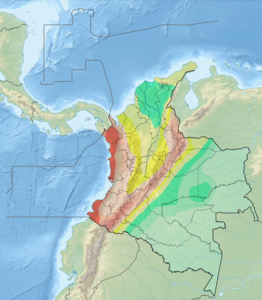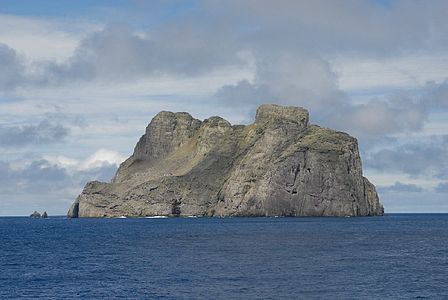
The North American Plate is a tectonic plate covering most of North America, Cuba, the Bahamas, extreme northeastern Asia, and parts of Iceland and the Azores. With an area of 76 million km2 (29 million sq mi), it is the Earth's second largest tectonic plate, behind the Pacific Plate.

The Juan de Fuca Plate is a small tectonic plate (microplate) generated from the Juan de Fuca Ridge that is subducting beneath the northerly portion of the western side of the North American Plate at the Cascadia subduction zone. It is named after the explorer of the same name. One of the smallest of Earth's tectonic plates, the Juan de Fuca Plate is a remnant part of the once-vast Farallon Plate, which is now largely subducted underneath the North American Plate.
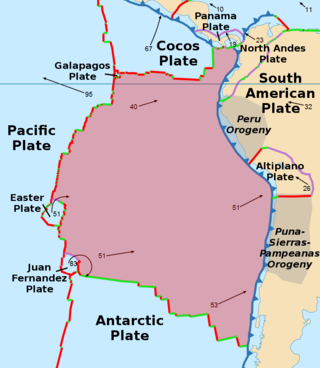
The Nazca Plate or Nasca Plate, named after the Nazca region of southern Peru, is an oceanic tectonic plate in the eastern Pacific Ocean basin off the west coast of South America. The ongoing subduction, along the Peru–Chile Trench, of the Nazca Plate under the South American Plate is largely responsible for the Andean orogeny. The Nazca Plate is bounded on the west by the Pacific Plate and to the south by the Antarctic Plate through the East Pacific Rise and the Chile Rise respectively. The movement of the Nazca Plate over several hotspots has created some volcanic islands as well as east-west running seamount chains that subduct under South America. Nazca is a relatively young plate both in terms of the age of its rocks and its existence as an independent plate having been formed from the break-up of the Farallon Plate about 23 million years ago. The oldest rocks of the plate are about 50 million years old.

The Cocos Plate is a young oceanic tectonic plate beneath the Pacific Ocean off the west coast of Central America, named for Cocos Island, which rides upon it. The Cocos Plate was created approximately 23 million years ago when the Farallon Plate broke into two pieces, which also created the Nazca Plate. The Cocos Plate also broke into two pieces, creating the small Rivera Plate. The Cocos Plate is bounded by several different plates. To the northeast it is bounded by the North American Plate and the Caribbean Plate. To the west it is bounded by the Pacific Plate and to the south by the Nazca Plate.

The Caribbean Plate is a mostly oceanic tectonic plate underlying Central America and the Caribbean Sea off the north coast of South America.

The Carnegie Ridge is an aseismic ridge on the Nazca Plate that is being subducted beneath the South American Plate. The ridge is thought to be a result of the passage of the Nazca Plate over the Galapagos hotspot. It is named for the research vessel Carnegie, which discovered it in 1929.

The Galapagos Microplate (GMP) is a geological feature of the oceanic crust located at 1°50' N, offshore of the west coast of Colombia. The GMP is collocated with the Galapagos Triple Junction, which is an atypical ridge-ridge-ridge triple junction. At the Galapagos Triple Junction, the Pacific Plate, Cocos Plate, and Nazca Plate meet incompletely, forming two counter-rotating microplates at the junction of the Cocos-Nazca, Pacific-Cocos, and Pacific-Nazca spreading ridges.
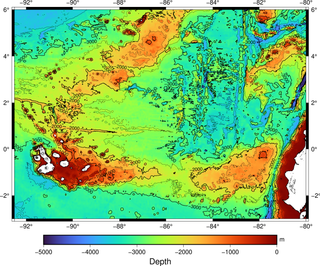
The Galápagos hotspot is a volcanic hotspot in the East Pacific Ocean responsible for the creation of the Galápagos Islands as well as three major aseismic ridge systems, Carnegie, Cocos and Malpelo which are on two tectonic plates. The hotspot is located near the Equator on the Nazca Plate not far from the divergent plate boundary with the Cocos Plate. The tectonic setting of the hotspot is complicated by the Galapagos Triple Junction of the Nazca and Cocos plates with the Pacific Plate. The movement of the plates over the hotspot is determined not solely by the spreading along the ridge but also by the relative motion between the Pacific Plate and the Cocos and Nazca Plates.
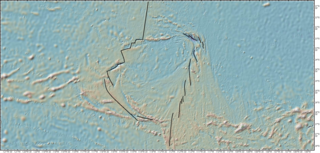
Easter Plate is a tectonic microplate located to the west of Easter Island off the west coast of South America in the middle of the Pacific Ocean, bordering the Nazca Plate to the east and the Pacific Plate to the west. It was discovered from looking at earthquake distributions that were offset from the previously perceived Nazca-Pacific Divergent boundary. This young plate is 5.25 million years old and is considered a microplate because it is small with an area of approximately 160,000 square kilometres (62,000 sq mi). Seafloor spreading along the Easter microplate's borders have some of the highest global rates, ranging from 50 to 140 millimetres /yr.

The Galapagos Triple Junction is a geological area in the eastern Pacific Ocean several hundred miles west of the Galapagos Islands where three tectonic plates - the Cocos Plate, the Nazca Plate and the Pacific Plate - meet. It is an unusual type of triple junction in which the three plates do not meet at a simple intersection. Instead, the junction includes two small microplates, the Galapagos Microplate and the Northern Galapagos Microplate, caught in the junction, turning synchronously with respect to each other and separated by the Hess Deep rift.
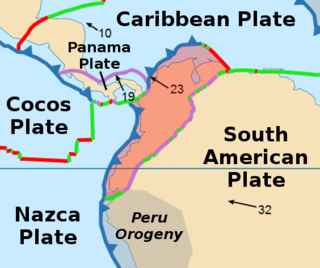
The North Andes Plate or North Andes Block is a small tectonic plate (microplate) located in the northern Andes. It is squeezed between the faster moving South American Plate and the Nazca Plate to the southwest. Due to the subduction of the Malpelo and Coiba Plates, this area is very prone to volcanic and seismic activity, with many historic earthquakes.

The Panama Plate is a microplate; a small tectonic plate that exists between two actively spreading ridges and moves relatively independently of its surrounding plates. The Panama plate is located between the Cocos Plate and Nazca Plate to the south and the Caribbean Plate to the north. Most of its borders are convergent boundaries including a subduction zone to the west. It consists, for the most part, of the nations of Panama and Costa Rica.
The 1906 Ecuador–Colombia earthquake occurred at 10:36:10 (UTC+5) on Wednesday January 31, 1906 off the coast of Ecuador, near Esmeraldas. The earthquake had a moment magnitude of 8.8 and triggered a destructive tsunami that caused at least 500 casualties on the coast of Colombia.

The Pacific Ocean evolved in the Mesozoic from the Panthalassic Ocean, which had formed when Rodinia rifted apart around 750 Ma. The first ocean floor which is part of the current Pacific Plate began 160 Ma to the west of the central Pacific and subsequently developed into the largest oceanic plate on Earth.
The Romeral Fault System is a megaregional system of major parallel and anastomosing faults in the Central Ranges of the Colombian Andes and the Cauca, Amagá, and Sinú-San Jacinto Basins. The system spans across ten departments of Colombia, from northeast to south Bolívar, Sucre, Córdoba, Antioquia, Caldas, Risaralda, Quindío, Valle del Cauca, Cauca and Nariño. The fault zone extends into Ecuador where it is known as the Peltetec Fault System. The in detail described part of the Romeral Fault System south of Córdoba has a total length of 697.4 kilometres (433.3 mi) with a cumulative length of 1,787.9 kilometres (1,110.9 mi) and runs along an average north to south strike of 017.6 ± 16, cross-cutting the central-western portion of Colombia.

The Bahía Solano Fault, Utría Fault or Utría-Bahía Solano Fault is a westward dipping thrust fault in the department of Chocó on the Pacific Coast of Colombia. The fault has a total length of 290.6 kilometres (180.6 mi) and runs along an average north–south strike of 347 ± 13 from the Panama-Colombia border to Bajo Baudó. The fault is partly offshore in the bays of Solano and Utría and crosses the Chocó Basin and the coastal Serranía del Baudó. Movement of the fault produced the Mw 6.5 1970 Bahía Solano earthquake.

The Coiba Plate is a small tectonic plate (microplate) located off the coasts south of Panama and northwestern Colombia. It is named after Coiba, the largest island of Central America, just north of the plate offshore southern Panama. It is bounded on the west by the Cocos Plate, on the south by the Malpelo Plate, on the east by the North Andes Plate, and on the north by the Panama Plate. This microplate was previously assumed to be part of the Nazca Plate, forming the northeastern tongue of the Nazca Plate together with the Malpelo Plate. Bordering the Coiba Plate on the east are the north-south striking Bahía Solano Fault and east of that, the Serranía de Baudó, an isolated mountain chain in northwestern Chocó, Colombia.
The geology of Panama includes the complex tectonic interplay between the Pacific, Cocos and Nazca plates, the Caribbean Plate and the Panama Microplate.
The Malpelo Ridge is an elevated part of Nazca Plate off the Pacific coast of Colombia. It is a faulted chain of volcanic rock of tholeiitic composition. The Malpelo Ridge may have originated simultaneously as Carnegie Ridge, and thus represent an old continuation of Cocos Ridge. It is thought to have acquired it present position due to tectonic movements along the Panama Fracture Zone.


